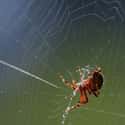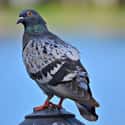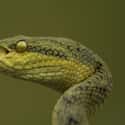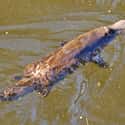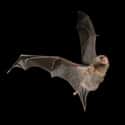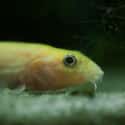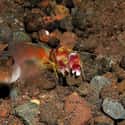-
(#1) Spiders Can Measure Their Prey And Predators Just By Sensing Them
Do these eight-legged critters possess all the powers of Spider-Man? No. But they do possess some truly incredible abilities that allow many to sit atop their food chain. All spiders contain a mechanoreceptor organ called slit sensilla, which allows them to sense the smallest physical deformations or strains on their exoskeleton. Spiders also use these organs to judge the size, weight, and perhaps even the kind of prey that gets caught in their web.
Their slit sensilla can be so discerning that spiders can tell the difference between prey, a predator, or even a strong gust of wind.
-
(#2) Comb Jellyfish Can Tell Direction Without Having Eyes
Jellyfish may be some of the oldest creatures living on planet earth, and are some of the first multi-celled organisms. This ancient animal evolved without eyes, arms, or even a central nervous system. Despite this, they manage to travel thousands of miles around the ocean each year. Specialized balance receptors called statocysts allow comb jellies to orient themselves and stay upright among the ocean’s currents. To make it even more impressive, comb jellies rely on their statocysts to better coordinate their cilia to reel in prey.
-
(#3) Plain Pigeon
- Patagioenas inornata
While these birds are most well-known for being a nuisance in cities nearly everywhere, one reason pigeons are found in so many parts of the world is because they have incredible migratory power. Thanks to a special sense called magnetoreception, which is a structure in their beaks that contains iron, pigeons can detect the Earth’s magnetic field, allowing them to pinpoint exactly where they are and whey they need to go.
This incredible skill is one of the reasons why homing pigeons were the first form of airmail, which dates back to 3,000 years ago. One of the coolest instances of homing pigeons was being used to proclaim the champions of the Olympic games in Ancient Greece.
-
(#4) Dolphin
- Delphinidae Delphis
The dolphin's incredible intelligence could be considered a sixth sense on it’s own, as they are possibly the smartest animals on the planet after humans. But their sixth sense is even more impressive. Dolphins' use of echolocation allow these animals to pinpoint what is in the water with them, including friends and foes. Echolocation relies on producing high-pitched clicks and squeals that travel through the ocean and bounce of obstructions, returning to a receptor in the dolphin’s head called a “melon.”
This ability, which can be compared to sonar, allows dolphins to see the world around them in a three-dimensional representation without the use of their eyes. This is especially important for river dolphins who live in dark and murky rivers, as opposed to the wide-open ocean.
-
(#5) Pit Vipers Have Infrared Vision
Depending on how snakes capture their prey, they have differing abilities and killer instincts. The pit viper, which live in both North and South America, has a skill so amazing, it’s a part of its name.
The “pit” in the venomous snake's name refers to two slits between the snake’s nostril and eye. These slits are heat-sensing organs that allow the snakes to see in infrared - meaning they can pick up on heat-sources even if in the middle of the night. The sense is so sensitive that pit vipers can accurately judge the size and distance of their prey using that sense alone.
-
(#6) Shark
- Selachimorpha
Sharks and rays have evolved to detect their various prey in the depths below. Electroreception is the ability these animals have to detect electrical fields in the surrounding area. Thanks to their salt-water habitat, which acts as a strong conductor of electricity, sharks can detect their prey through the tiny electrical charges that occur when a fish - or something bigger - contracts its muscles.
The sense is so powerful that some sharks can pick up a charge equivalent to two AA batteries being connected 1,000 miles apart. The hammerhead shark’s famous cranial shape is actually specifically designed to enhance their electroreception ability.
-
(#7) Platypus
- Ornithorhynchus anatinus
One of the most enigmatic creatures in the natural world, the amphibious marsupial is one of the rare mammals that lays eggs. But that’s not the only thing that sets them apart. They have an electroreceptive sense within the skin of their duck-like bill that allows them to sense their prey when it comes near the platypus or its family. Scientists say platypuses can feel signals produced by another animals heartbeat or nerves. Their bill is also lined with mechanoreceptors which give them an ability to sense tiny stimuli, as the bill behaves much like a human’s fingertips.
When you see a platypus hunt in the water, it shakes its head from side-to-side as a way to enhance the sense. It will sift its bill through the river’s sedimentary floor to sense its prey, picking up any vibrations in the water.
-
(#8) Atlantic salmon
- Salmo salar
Salmon have puzzled scientists for years. Millions of them are able to pinpoint the exact rivers and streams they were born in to spawn. While how exactly salmon are able to travel thousands of miles to find their exact place of birth remains a scientific mystery, many believe they use ferromagnetic mineral magnetite deposits in their bodies to use the Earth’s magnetic field.
These deposits are attracted to magnetic forces and work as an internal GPS of sorts. Researchers theorize they imprint the magnetic field where they're born and are hardwired to return there thanks to the built-in navigation system. Additionally, salmon have an incredible sense of smell, which may allow them to smell the difference between their home streams and other streams.
-
(#9) Evening Bat
- Nycticeius humeralis
Bats might scare some people because they can fly at fast speeds in the dark of night. But really, bats aren't scary at all - they're actually incredible. Being able to fly at night isn't because they have great eyesight, it's because of their ability to use echolocation, much like their aquatic mammalian cousin, the dolphin.
Insectivorous bats are able to fly through dark caves and the night sky in search of their prey thanks to their larynx’s ability to generate ultrasound through their mouth and nose. Much like the dolphin, the bat’s echolocation paints a three-dimensional view of the world around them. In fact, the reason many insectivorous bats have wrinkled faces is because they act much like the inside of an ear and pick up sound.
-
(#10) Weatherfish Got Their Name Because They Can Predict Weather
These fish are so good at “predicting” the weather it’s in their name. Indigenous to Europe and Asia, this species has the incredible ability to detect changes in atmospheric pressure. The fish use this ability to monitor the buoyancy underwater - which changes slightly with high and low pressure systems - to compensate for the lack of a swim bladder, or organs that help control buoyancy in fish. When a big storm is coming, these fish become more active, signaling for fisherman to take cover.
The scientific name for the weatherfish, Misgurnus, comes from the words miseo (hate) and the Turkish word gür (thunder), a name that was given to the fish because they become noticeably more active during barometric pressure changes that take place just before thunderstorms.
-
(#11) Catfish
- Siluriformes
While taste is a sense most living things possess, the vast majority of animals have to put something in their mouths. Not so for the catfish, whose body is covered in taste-sensitive cells. This allows them to taste in all directions from the water that flows over them, giving them a taste of prey from far away. It also gives them a sense of direction in the muddy, murky waters they call home.
Their whiskers alone have 100,000 taste buds on them - compare that to the average 10,000 taste buds we humans have.
-
(#12) Opossum
- Didelphimorphia
The North American opossum’s most common defense mechanism is to simply fake its own death, causing predators to lose interest. But what most people don't know is that the opossum has a few tricks up its sleve: opossums have one more incredible ability that allows them to literally cheat death.
The opossum is able to utilize a protein in their body called LTNF, making them immune to the venom of snakes, bees, and scorpions. Once venom is detected in the opossum’s body, the protein actively seeks it out and works to neutralize it. Incredibly, the LTNF protein does not serve as a defense against venomous predators indigenous to that area, it can defend against venom found all over the world.
-
(#13) Pistol Shrimp Can Generate Shockwaves
How can a type of shrimp that is only three to five centimeters in length be responsible for a large amount of noise in the entire ocean? It might seem hard to believe, but a single pistol shrimp can make more noise than a jet engine. The pistol shrimp uses its one oversized claw to kill its prey by using the claw’s pistol-like hammer to snap together, emitting an incredibly powerful wave of bubbles, which kills its prey of much-larger fish. The shockwave emitted from their claw can even break small glass jars.
Though the sound of the clicks only last 1 millisecond, they compete with the much larger sperm and beluga whales for loudest animal in the known ocean. When these shrimp live together in colonies, the nose they make can interfere with sonar and underwater communication.
New Random Displays Display All By Ranking
About This Tool
The ancient Greek philosopher Aristotle believed that there are five kinds of human senses: sight, hearing, smell, taste, and touch. However, many people believe that there is a sixth sense, especially in women. Does the sixth sense exist or not? So far, people have no definitive answer. However, some scientists have some new discoveries about the ways of animals' sixth sense through animal experiments.
The interesting thing is that there is a sixth sense in the animal kingdom, and this is not a superpower. With this random tool, you could know how these 13 animals have a sixth sense, they have crazy skills to survive.
Our data comes from Ranker, If you want to participate in the ranking of items displayed on this page, please click here.










